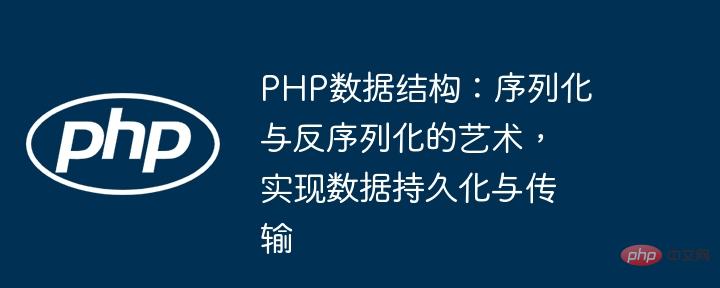 Backend Development
Backend Development
 PHP Tutorial
PHP Tutorial
 PHP data structure: the art of serialization and deserialization, achieving data persistence and transmission
PHP data structure: the art of serialization and deserialization, achieving data persistence and transmission
PHP data structure: the art of serialization and deserialization, achieving data persistence and transmission
In PHP, serialization converts the data structure into a string, while deserialization restores the string into a data structure to achieve data persistence and transmission. The serialization function serialize converts a data structure into a string, while the unserialize function restores serialized data from a string. Serialization can be used for data persistence (saving to a file) and data transfer (via HTTP POST requests).

PHP Data Structure: The Art of Serialization and Deserialization
In PHP, serialization is a data structure The process of converting to a string, while deserialization is the process of restoring a string to a data structure. Together they enable data persistence and transmission.
Serialization
Serialization converts complex PHP data structures into a string that can be stored in a file or database, or transmitted over the network. Here is an example of how to serialize using the serialize function:
$data = ['name' => 'John Doe', 'age' => 30]; $serialized = serialize($data);
This will create a string containing the serialized data, stored in the $serialized variable .
Deserialization
To restore serialized data from a string, you can use the unserialize function:
$unserialized = unserialize($serialized);
This will create a new data structure containing the same data as the original data structure.
Practical Case: Data Persistence
Serialization allows data to be persisted to a file for later reading. This is useful for caching data or creating persistent sessions. For example, to save serialized data to a file:
file_put_contents('data.txt', $serialized);You can later read data from the file and deserialize it:
$data = unserialize(file_get_contents('data.txt'));Practical case: data transfer
Serialization can also be used to transmit data over the network. For example, to transmit serialized data via an HTTP POST request:
$post_data = ['name' => 'John Doe', 'age' => 30]; $serialized_data = serialize($post_data); $params = ['data' => $serialized_data];
On the receiving end, use the unserialize function to deserialize the data:
$unserialized_data = unserialize($_POST['data']);
By using serialization and deserialization With serialization, you can easily persist PHP data structures to files or transfer them over the network for reliable transmission and storage of data.
The above is the detailed content of PHP data structure: the art of serialization and deserialization, achieving data persistence and transmission. For more information, please follow other related articles on the PHP Chinese website!

Hot AI Tools

Undresser.AI Undress
AI-powered app for creating realistic nude photos

AI Clothes Remover
Online AI tool for removing clothes from photos.

Undress AI Tool
Undress images for free

Clothoff.io
AI clothes remover

AI Hentai Generator
Generate AI Hentai for free.

Hot Article

Hot Tools

Notepad++7.3.1
Easy-to-use and free code editor

SublimeText3 Chinese version
Chinese version, very easy to use

Zend Studio 13.0.1
Powerful PHP integrated development environment

Dreamweaver CS6
Visual web development tools

SublimeText3 Mac version
God-level code editing software (SublimeText3)

Hot Topics
 CakePHP Project Configuration
Sep 10, 2024 pm 05:25 PM
CakePHP Project Configuration
Sep 10, 2024 pm 05:25 PM
In this chapter, we will understand the Environment Variables, General Configuration, Database Configuration and Email Configuration in CakePHP.
 PHP 8.4 Installation and Upgrade guide for Ubuntu and Debian
Dec 24, 2024 pm 04:42 PM
PHP 8.4 Installation and Upgrade guide for Ubuntu and Debian
Dec 24, 2024 pm 04:42 PM
PHP 8.4 brings several new features, security improvements, and performance improvements with healthy amounts of feature deprecations and removals. This guide explains how to install PHP 8.4 or upgrade to PHP 8.4 on Ubuntu, Debian, or their derivati
 CakePHP Date and Time
Sep 10, 2024 pm 05:27 PM
CakePHP Date and Time
Sep 10, 2024 pm 05:27 PM
To work with date and time in cakephp4, we are going to make use of the available FrozenTime class.
 CakePHP File upload
Sep 10, 2024 pm 05:27 PM
CakePHP File upload
Sep 10, 2024 pm 05:27 PM
To work on file upload we are going to use the form helper. Here, is an example for file upload.
 CakePHP Routing
Sep 10, 2024 pm 05:25 PM
CakePHP Routing
Sep 10, 2024 pm 05:25 PM
In this chapter, we are going to learn the following topics related to routing ?
 Discuss CakePHP
Sep 10, 2024 pm 05:28 PM
Discuss CakePHP
Sep 10, 2024 pm 05:28 PM
CakePHP is an open-source framework for PHP. It is intended to make developing, deploying and maintaining applications much easier. CakePHP is based on a MVC-like architecture that is both powerful and easy to grasp. Models, Views, and Controllers gu
 CakePHP Creating Validators
Sep 10, 2024 pm 05:26 PM
CakePHP Creating Validators
Sep 10, 2024 pm 05:26 PM
Validator can be created by adding the following two lines in the controller.
 How To Set Up Visual Studio Code (VS Code) for PHP Development
Dec 20, 2024 am 11:31 AM
How To Set Up Visual Studio Code (VS Code) for PHP Development
Dec 20, 2024 am 11:31 AM
Visual Studio Code, also known as VS Code, is a free source code editor — or integrated development environment (IDE) — available for all major operating systems. With a large collection of extensions for many programming languages, VS Code can be c





